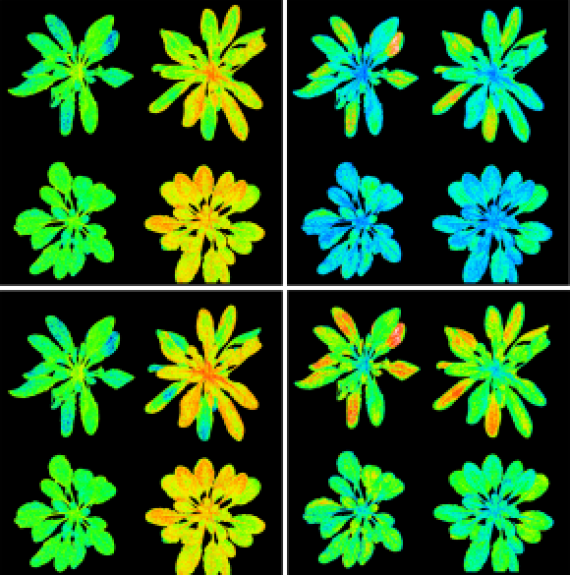Plant researchers have rapidly learned enough about photosynthesis to be able to suggest effective options for improving the process in plants. ‘We have proof of principle that we can improve photosynthesis’, says WUR researcher Jeremy Harbinson, who works on photosynthesis in the Biophysics chair group.
Harbinson is co-author of a recent publication in which geneticists from Wageningen described how they were able to improve the photosynthesis in the model plant Arabidopsis thaliana. He is also aware of the recent American research in which scientists were able to boost the photosynthetic capacity of tobacco. This research was done by the research group led by Donald Ort, Biology professor at the University of Illinois. Ort will give a guest lecture in Wageningen at the Dies Natalis on 9 March.
How does it work?
A brief explanation of photosynthesis before we go on. A plant cell looks like a green soup with a nucleus that contains most of the DNA, the chloroplasts – the seat of photosynthesis – in which sunlight is used to drive the formation of sugars from CO2, and the mitochondria where respiration occurs. The chloroplasts and mitochondria were originally bacteria that were long ago incorporated into plant cells.
Organelles in a plant have successfully been replaced by organelles from another plant
The conversion of sunlight into energy in the plant cells does not always proceed without a hitch. The plants produce an enzyme called Rubisco, which catalyzes the conversion of CO2 from the air into organic molecules. But in about 20 per cent of cases, the enzyme catalyzes a reaction between oxygen and the target molecule, producing toxins and necessitating a detoxification process. The result is a big loss of photosynthetic efficiency. To improve photosynthesis, Ort’s research group silenced a gene in tobacco plants that was important in the detoxification process and replaced it with alternative detox genes. As a result, the tobacco plants produced 40 per cent more biomass.
Another group at the University of Illinois, including WUR alumnus Wanne Kromdijk, found a different way to improve photosynthesis. Plants have a mechanism for protecting themselves against intense sunlight. They temporarily reduce the efficiency of photosynthesis in order to protect their leaves against radiation. On a cloudy day, plants continuously switch their sun protection tool on and off. This switch is quite slow, however, while changes in sunlight can be fast. The Illinois group were able to speed up the switch. As a result, plant growth improved by 10 to 15 per cent.
Breakthrough
The aim of these interventions is to increase food production in order to feed the growing world population. The researchers haven’t reached that goal yet, though. The improvements in photosynthesis have so far been made in model plants like Arabidopsis and tobacco, and not in crops. Secondly, the pioneering American research made use of genetic modification to improve photosynthesis. This would conflict with European legislation.
‘For that reason,’ says Harbinson, ‘the Wageningen approach is to use natural variation to improve photosynthesis. To do this we first have to identify natural variation in photosynthetic traits within a plant species and then find the genetics behind this variation. The aim is to improve photosynthesis through cross-breeding and selection.’
Improving photosynthesis poses a new challenge for plant scientists and plant-breeding companies. So far they focused on the genes within the nucleus of the plant cell, where the most genetic information is stored. Some genes, however, are found in chromosomes in the chloroplasts and mitochondria. Analyzing the contribution these genes make to variation in photosynthesis and other processes is not easy.
Father and mother plant
Last month, however, Wageningen geneticists reported on a new method for more systematically exploring the impact of the chloroplast and mitochondrial genomes on plant variation. For the first time, their method allows the organelles from one plant to be easily replaced by organelles from another. This could prove to be a breakthrough in photosynthesis research.
PhD student Tom Theeuwen and co-author Erik Wijnker from the Laboratory of Genetics did photosynthesis research with Arabidopsis thaliana (thale cress). They already knew that Arabidopsis showed natural variation in photosynthesis capacity. But then they found a mutant of the thale cress with a genetic defect: during crossbreeding it only passed on the genetic information of the male parent to the offspring. This mutant served them well, because now they could create varieties that automatically contained the DNA from the cell nucleus of the father plant and the organelles of the mother plant. In other words, they could produce genetically identical plants with different photosynthesis engines.
When the Wageningen geneticists started to measure the photosynthesis capacity of these plants, they indeed found variation in the photosynthesis. ‘Our research shows that we can improve the photosynthetic properties of plants’, says Theeuwen. Note, however, that this research was not done on a food crop either, and it too made use of GM techniques. Moreover, these techniques only work within plant species, in this case Arabidopsis. In order to use this strategy on food crops, researchers would need mutants of food crops that only pass on male genetic information. It would be a hell of a job to find these.
But plant breeders have an easier method at their disposal, says Wijnker. They can crossbreed a male and female plant of, for instance, tomato and then continue breeding with the father plant only. After six to seven generations, the DNA of the offspring is nearly identical to the original male. Plant breeders can use these plants for crossbreeding trials.
| DIES NATALIS |
|---|
| The Executive Board cordially invites you to attend the celebration of the 102nd Dies Natalis on Monday 9 March 2020. The theme of the day is Illuminating Science for Transition, with a focus on fundamental research that supports transitions. Donald Ort, professor of Biology at the University of Illinois, will discuss his fundamental research on photosynthesis. Three young Wageningen scientists will present their fundamental research in relation to transitions. |

 Photo: Tom Theeuwen
Photo: Tom Theeuwen